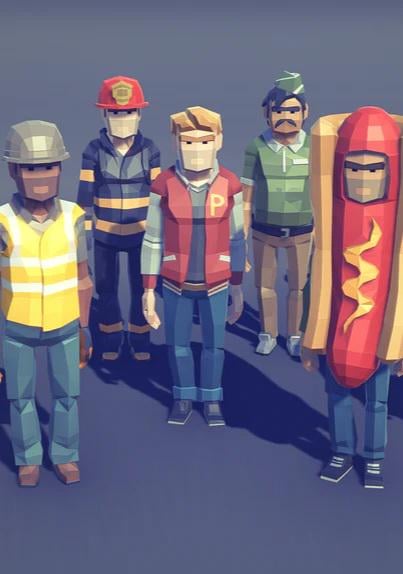From Goat Simulator to Indie Dreams: Why Coffee Stain North is Betting on Creative Freedom As a game designer who's straddled both the AAA and indie worlds, I’ve seen firsthand the allure and the challenges of each.

As a game designer who's straddled both the AAA and indie worlds, I’ve seen firsthand the allure and the challenges of each. For four years, I was a level designer at Ubisoft Montreal, contributing to sprawling open-world games. Now, I'm a lead designer at Pixel Bloom Games, a small indie studio crafting a narrative-driven puzzle game with a distinctive watercolor art style. The contrast is stark, and it’s a contrast that many developers are increasingly considering. That's why Coffee Stain North's recent announcement – that they're moving away from AAA development to focus on smaller, more experimental projects – is so significant.
This image perfectly captures the two sides of the game development spectrum: the wild, unbridled chaos of Goat Simulator 3 and the focused, artistic vision of indie development.
The AAA Grind: Prestige, Resources, and Burnout
Let’s be honest: working at a AAA studio like Ubisoft, CD Projekt Red (Cyberpunk 2077), or Rockstar (Grand Theft Auto) offers undeniable perks. The prestige is real. You’re contributing to titles that millions of people will play. The resources are vast, providing access to cutting-edge technology and talented colleagues. Career advancement opportunities are plentiful, and the salaries are generally quite competitive.
But the AAA world also comes with its own set of challenges. The sheer scale of these projects can lead to burnout. The creative process can feel diluted, with numerous stakeholders weighing in on every decision. Your individual impact can feel minimal, lost in the sea of hundreds of developers. While I learned a great deal during my time at Ubisoft, there were moments where I felt like a cog in a machine, executing someone else's vision rather than contributing my own.

This image highlights the potential for burnout and stress within AAA game development.
Coffee Stain North: Embracing the Absurd and the Indie Spirit
Coffee Stain North, the brains behind the Goat Simulator franchise, built their success on intentionally janky, physics-based gameplay and absurd humor. These were design choices that might have been deemed too risky or unconventional in a more risk-averse AAA environment. The original Goat Simulator was, in many ways, a happy accident – a small project that unexpectedly exploded in popularity. It proved that sometimes, the most successful games are the ones that break the rules.
Their move away from AAA signifies a desire to recapture that spark, to focus on smaller, more experimental projects where creative freedom reigns supreme. It’s a bold move, but one that resonates with a growing number of developers who are seeking more fulfilling and sustainable careers. This transition highlights the increasing appeal of indie game development for experienced developers burnt out by the AAA grind.

This image reminds us of the quirky and unconventional nature of Goat Simulator and its origins in experimental game design.
The Indie Alternative: Creative Control and Financial Uncertainty
The indie world offers a vastly different experience. At Pixel Bloom Games, I have a direct say in almost every aspect of our game. From the core mechanics to the narrative direction to the visual style, my voice is heard and valued. That level of creative control is incredibly empowering.
However, the indie life also comes with its own set of challenges. Resources are limited. Marketing reach is significantly smaller. And financial stability is never guaranteed. We're a self-funded studio, which means we're constantly juggling budgets and making tough decisions about where to allocate our resources. There’s a real risk involved – a feeling of constantly walking a tightrope.

This image symbolizes the constant balancing act between creative freedom and financial stability that indie developers face.
Campo Santo, Fullbright, and the Pursuit of Passion Projects
Coffee Stain North's decision echoes similar moves made by other studios known for quirky or experimental titles. Campo Santo, the creators of Firewatch, and Fullbright, the studio behind Gone Home, both carved out their niches by focusing on smaller, narrative-driven experiences. These studios demonstrated that you don't need a massive budget or a hundred-person team to create something meaningful and impactful.
These examples illustrate how successful game developers are leaving AAA companies to pursue their passion projects and achieve a better work-life balance in indie game development.

This image highlights the success of Campo Santo and Fullbright in creating compelling narrative experiences outside the AAA space.
Fewer Stakeholders, More Ownership
One of the biggest differences between AAA and indie development is the number of stakeholders involved. In a AAA studio, you're often working within a complex hierarchy, with layers of approval and feedback required for every decision. In an indie studio, the decision-making process is much more streamlined. There are fewer voices to appease, which allows for a more direct and personal connection to the project.
This sense of ownership is incredibly rewarding. When you pour your heart and soul into a game, and you see it resonate with players, it's a feeling that's hard to replicate in the AAA world. This creative control in indie games is often cited as a major draw for developers leaving AAA studios.

This image clearly visualizes the differences in organizational structure between AAA and indie studios.
Navigating the Challenges of Indie Development
Working at Pixel Bloom Games has been an incredible learning experience. I've had to wear many hats, from level designer to marketing strategist to community manager. It's demanding, but it's also incredibly fulfilling. I'm constantly learning new skills and pushing myself outside of my comfort zone.
However, it's important to acknowledge the risks. The indie game market is crowded, and it's difficult to stand out. Marketing and visibility are major hurdles. Securing funding can be a constant struggle. And the pressure to succeed can be immense. But these challenges are what make the rewards even sweeter. Overcoming obstacles, building something from the ground up, and seeing your vision come to life – those are the things that make indie development so compelling.

This image encapsulates the dedication and determination required to succeed in the indie game development world.
A Hopeful Sign for the Future
Coffee Stain North's decision to embrace indie development could be a positive sign for the future of the industry. It suggests a growing recognition that creative freedom and developer well-being are just as important as financial success. It's a validation of the indie spirit, a reminder that games can be more than just products – they can be works of art, passion projects that reflect the unique vision of their creators. This shift from AAA to indie development could also lead to more sustainable game development practices in the long run.

This image beautifully symbolizes the growth and potential within the indie game development world.
Conclusion: The Allure of the Indie Dream
The transition from AAA to indie isn't for everyone. It requires a willingness to embrace risk, to wear many hats, and to sacrifice some of the security and resources that come with working for a large studio. However, for those who are seeking creative freedom, a stronger sense of ownership, and a more sustainable work-life balance, the indie world offers a compelling alternative. Coffee Stain North's move is a testament to the growing appeal of this alternative, a signal that the future of game development may be shifting towards smaller, more experimental, and ultimately, more fulfilling models. And for someone like me, who's found a home in the indie space, it's an exciting prospect indeed. I hope this offers some helpful indie game development career advice for those considering a similar path.
